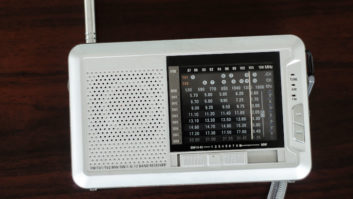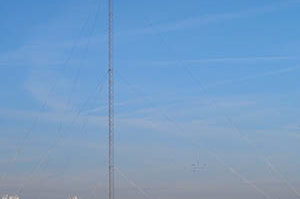(click thumbnail)Clockwise from upper left are the Grundig Classic 960, Grundig Satellit 800 Millennium, Sun-Mate Info-Mate, Grundig Mini World 100 PE, Sangean ATS-505 and Panasonic RF2200.Despite all the talk about satellite and Internet radio, and despite the BBC’s recent pullback of shorwave services to North America, a number of international broadcasters have been investing in updating and improving their shortwave transmission systems.
And while many people may not have noticed, manufacturers of shortwave receivers have been similarly busy.
Earlier this year, to get a sense of what sorts of receivers are available, I requested samples from Grundig, Sangean and Sun-mate. For good measure, and to serve as a basis for comparison, I hauled out my trusty Panasonic RF-2200.
The RF-220 is a venerable 1970s-era multiband receiver that, for many, was one of the best analog transistor radios ever made.
Different sets
Grundig sent three very different sets to test.
The first was the Grundig Satellit 800 Millennium. With a weight of 6.5 kilograms, measurements of 52 x 22.8 by 20.3 centimeters, and unmatched audio quality, the Millennium is the top-of-the-line offering from Grundig.
For More InfoPrices shown are suggested list price; street prices may be substantially lower.
Grundig Classic 960 ($249.95) www.grundig.com
Grundig Satellit 800 Millennium ($699.95)
Grundig Mini World 100 PE ($39.95) Sun-Mate Info-Mate www.sunmate.com Sangean ATS-505 ($179) www.sangean.com
Panasonic RF2200 (Discontinued) www.panasonic.com
It has all the bells and whistles: continuous coverage, digital circuitry, direct keypad input, single sideband (SSB) for amateur radio and CW (code) reception, three adjustable bandwidth filters, digital readout and programmable memories.
At the other end of the scale was the Grundig Mini World 100 PE, the smallest of the bunch.
In fact, the 100 PE often is called the “World’s Smallest Shortwave Receiver.” At 6.9 by 10.1 by 1.9 centimeters in size and a weight of just 125 grams, the label fits.
This is an analog, dial-driven set that can use either a built-in speaker or headsets. It features six shortwave bands, plus AM and FM; and there is no SSB or adjustable filters.
In between was the Grundig Classic 960. This is a 50th anniversary version of the classic Grundig AM/FM/SW radio.
In a word, it is beautiful: a solid wood-cased radio complete with fabric speaker cloth and brass emblems. In fact, the Classic 960t looks like it is fresh from the 1950s. It sounds good, too.
From Sangean, I received the ATS-505 portable. In terms of capabilities, this unit has virtually the same features as the Grundig Millennium, including digital circuitry, direct keypad entry, SSB and memory presets. Yet it is only about the size of a paperback book.
Granted, the audio is not quite as good as the giant-sized Grundig – or the Grundig Classic 960 – but it is still very good. As well, you can always use the supplied ear-bud headphones.
Solar power
The Sun-Mate Info-Mate radio is not one that one would expect in this kind of review, because its main feature is that the radio can be powered using a built-in hand-cranked generator, built-in solar panels, a car lighter adaptor, AC or included rechargeable Ni-Cad batteries.
However, since the 11-band Info-Mate uses Hitachi technology and tunes a number of shortwave bands, I decided to include it. It is about the size of the ATS-505.
Finally, there is old Panasonic RF2200: a bit long in the tooth right now, but still going strong after all these years.
All the radios were compared against each other, on the same frequencies and at the same time. For reception, I either used the built-in whip antenna on the set or the 6-meter rollout wire antenna supplied by Grundig.
Without a doubt, the Grundig Millennium won hands down in all categories except portability and price. It just sounds better, is relatively easy to use – as much as any world-band radio is – and has good sensitivity to signals.
In particular, the bandwidth filters on the Millennium, which allow users to block out adjacent stations by narrowing the amount of spectrum being received, are a blessing. It was easily the best all-round listening set I worked with.
Close behind was the Sangean ATS-505. It just did not sound as good as the Millennium, due to its smaller speaker. However, it is worth remembering that the ATS-505 costs a good bit less.
Performance
When it came to performance, the ATS-505 and the Millennium were head-to-head, based on my subjective Signal-Interference-Noise-Propagation-Overall (SINPO) ratings.
For instance, the Millennium won out receiving Radio Sweden International on 18960 kHz at 12:50 UTC. However, the ATS-505 did better with the BBC on 9515 kHz 25 minutes earlier, simply because it somehow avoided an annoying hum that the Grundig picked up.
My verdict: for versatile performance on a budget, the ATS-505 is the best choice.
The Number Three slot was shared by the venerable Panasonic RF2200, the Mini World 100 PE and – surprise – the Info-Mate. Depending on the station, each set showed better performance than the other two.
The morale is that if portability is what is most important, then buy the Mini World 100 PE. If you don’t want to worry about a power source, then buy the solar-powered Info-Mate.
Which brings me to the Grundig Classic 960. It has a great look and great sound; it even has input jacks for CDs or computer audio.
But as for shortwave reception, the two world bands on the Classic 960, although continuous, are too crowded; just like a 50-year-old radio would be.
This is a receiver for those who love the look of a classic radio, and whose shortwave listening tends towards BBC and other strong, easily received stations. This said, the Grundig Classic 960 still a work of art, as far as I am concerned.







